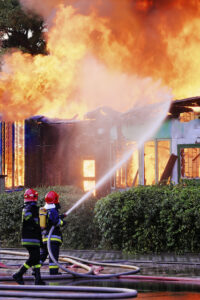
Today, we’ll peel back the layers that compose the assembly for a firefighter uniform and explain each layer’s function.
We all know what a true hero looks like. In the news, firefighters make striking appearances confronting scenarios that exceed our biggest nightmares. Today, we will take a much closer look at the new protective gear that helps them navigate dangerous situations at work safely. A fire suit is a lot more than just the khaki or navy fabric and reflective stripes that we notice at first glance. In today’s blog from Hanover Uniform, we will peel back the layers that compose the assembly for a firefighter uniform and explain each layer’s function. Read on to learn more!
Firefighter Uniform: Outer Layer
As the external layer, the outer layer of a firefighter uniform is the most durable component of the fire suit’s assembly. Among its main functions are:
- Excellent protection from flames and heat
- Protection against external chemicals and water
- Protection against cuts, lacerations, and abrasion
The durability and overall performance of the outer layer’s overall fabric are determined by its composition and construction, along with its weight. The biggest trend we see in 2022 is for fabrics to be as light as possible to reduce all heat stress and discomfort while still performing to ideal satisfaction in terms of physical and thermal protection.
Moisture Barrier
The moisture barrier is the central, middle layer of a firefighter suit’s assembly. Its main function is to help provide protection against the penetration of chemicals, water, and bloodborne pathogens. The moisture barrier plays a massive role in the breathability and insulation of the entire suit, and therefore, the overall level of protection and comfort for the wearer. It is usually made of a composite assembly in which a breathable waterproof film that is bonded to an FR substrate. The main orientation of the membrane within the assembly affects the central performance in the following ways:
- The membrane facing the outer shell provides better insulation along with thermal protection.
- The membrane facing the body: provides better breathability and comfort.
Thermal Barrier
As the innermost layer, your thermal barrier plays a huge role in the overall performance of the firefighter suit’s assembly. Its primary priorities are:
- Providing insulation by creating some air cushions and microclimate chambers within the garment to help favor comfort and helps minimize heat stress.
- Wicking moisture away from your body to increase comfort.
- Facilitating easy donning and doffing of the garment. A slick liner will help provide a perceived sense of comfort as the wearer will not need to fight with the garmants in order to put on or move in the firefighter uniform.
For Quality Uniforms and Work Supplies, Give Hanover Uniform a Call Today
Hanover Uniform is a dependable and privately held uniform supplier dedicated to serving your business with whichever uniform or work supply needs that you have. Our professional team is ready to serve customers all across Baltimore, Maryland! Large or Small, we’re invested in making you look good! We are here to help with every step.
For more information on how we can help your business, visit our website or give us a call at 800-541-9709 or 410-235-8338!
